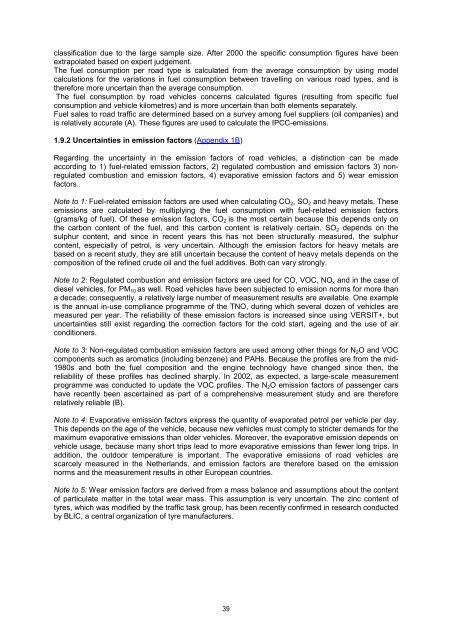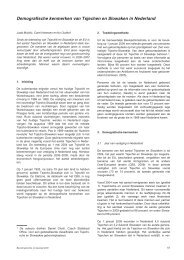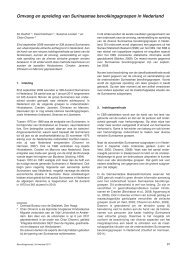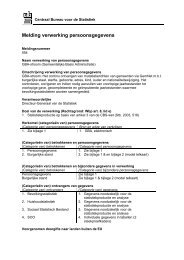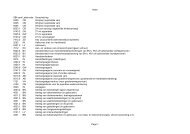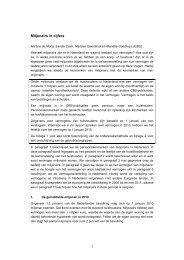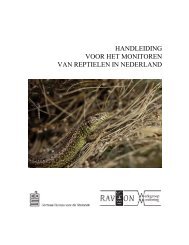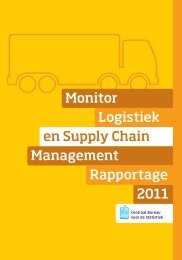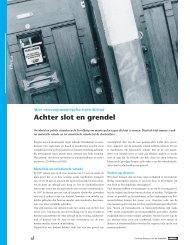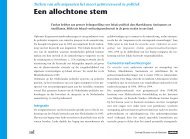Methoden voor de berekening van de emissies door mobiele ... - CBS
Methoden voor de berekening van de emissies door mobiele ... - CBS
Methoden voor de berekening van de emissies door mobiele ... - CBS
You also want an ePaper? Increase the reach of your titles
YUMPU automatically turns print PDFs into web optimized ePapers that Google loves.
classification due to the large sample size. After 2000 the specific consumption figures have been<br />
extrapolated based on expert judgement.<br />
The fuel consumption per road type is calculated from the average consumption by using mo<strong>de</strong>l<br />
calculations for the variations in fuel consumption between travelling on various road types, and is<br />
therefore more uncertain than the average consumption.<br />
The fuel consumption by road vehicles concerns calculated figures (resulting from specific fuel<br />
consumption and vehicle kilometres) and is more uncertain than both elements separately.<br />
Fuel sales to road traffic are <strong>de</strong>termined based on a survey among fuel suppliers (oil companies) and<br />
is relatively accurate (A). These figures are used to calculate the IPCC-emissions.<br />
1.9.2 Uncertainties in emission factors (Appendix 1B)<br />
Regarding the uncertainty in the emission factors of road vehicles, a distinction can be ma<strong>de</strong><br />
according to 1) fuel-related emission factors, 2) regulated combustion and emission factors 3) nonregulated<br />
combustion and emission factors, 4) evaporative emission factors and 5) wear emission<br />
factors.<br />
Note to 1: Fuel-related emission factors are used when calculating CO2, SO2 and heavy metals. These<br />
emissions are calculated by multiplying the fuel consumption with fuel-related emission factors<br />
(grams/kg of fuel). Of these emission factors, CO2 is the most certain because this <strong>de</strong>pends only on<br />
the carbon content of the fuel, and this carbon content is relatively certain. SO2 <strong>de</strong>pends on the<br />
sulphur content, and since in recent years this has not been structurally measured, the sulphur<br />
content, especially of petrol, is very uncertain. Although the emission factors for heavy metals are<br />
based on a recent study, they are still uncertain because the content of heavy metals <strong>de</strong>pends on the<br />
composition of the refined cru<strong>de</strong> oil and the fuel additives. Both can vary strongly.<br />
Note to 2: Regulated combustion and emission factors are used for CO, VOC, NOx and in the case of<br />
diesel vehicles, for PM10 as well. Road vehicles have been subjected to emission norms for more than<br />
a <strong>de</strong>ca<strong>de</strong>; consequently, a relatively large number of measurement results are available. One example<br />
is the annual in-use compliance programme of the TNO, during which several dozen of vehicles are<br />
measured per year. The reliability of these emission factors is increased since using VERSIT+, but<br />
uncertainties still exist regarding the correction factors for the cold start, ageing and the use of air<br />
conditioners.<br />
Note to 3: Non-regulated combustion emission factors are used among other things for N2O and VOC<br />
components such as aromatics (including benzene) and PAHs. Because the profiles are from the mid-<br />
1980s and both the fuel composition and the engine technology have changed since then, the<br />
reliability of these profiles has <strong>de</strong>clined sharply. In 2002, as expected, a large-scale measurement<br />
programme was conducted to update the VOC profiles. The N2O emission factors of passenger cars<br />
have recently been ascertained as part of a comprehensive measurement study and are therefore<br />
relatively reliable (B).<br />
Note to 4: Evaporative emission factors express the quantity of evaporated petrol per vehicle per day.<br />
This <strong>de</strong>pends on the age of the vehicle, because new vehicles must comply to stricter <strong>de</strong>mands for the<br />
maximum evaporative emissions than ol<strong>de</strong>r vehicles. Moreover, the evaporative emission <strong>de</strong>pends on<br />
vehicle usage, because many short trips lead to more evaporative emissions than fewer long trips. In<br />
addition, the out<strong>door</strong> temperature is important. The evaporative emissions of road vehicles are<br />
scarcely measured in the Netherlands, and emission factors are therefore based on the emission<br />
norms and the measurement results in other European countries.<br />
Note to 5: Wear emission factors are <strong>de</strong>rived from a mass balance and assumptions about the content<br />
of particulate matter in the total wear mass. This assumption is very uncertain. The zinc content of<br />
tyres, which was modified by the traffic task group, has been recently confirmed in research conducted<br />
by BLIC, a central organization of tyre manufacturers.<br />
39


